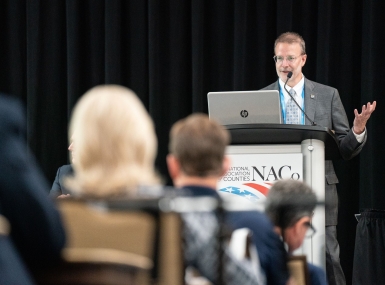Counties tackle ‘backwater’ broadband

 Rural county living typically means taking a little longer to get from place to place. Unfortunately for many, that includes their data via the Internet.
Rural county living typically means taking a little longer to get from place to place. Unfortunately for many, that includes their data via the Internet.
Distance and low population density make broadband expensive, so creative thinking is necessary for expanding service.
"We're what I call a 'broadband backwater,'" said Martin County, Fla. CIO Kevin Kryzda. "Our population density gives us the least favorable rates from service providers. We're either paying a lot or getting bad service."
With less favorable rates compared to the denser nearby Miami-Dade, Broward and Palm Beach counties, Martin County was facing a rate hike in 2009, and Kryzda explored the county's options. Their previous provider would increase its rates by 10 times over the next five years, ending up at $1.4 million a year. Another quote came in at $2 million a year.
Kryzda weighed leasing space on a broadband network or building one specifically for the county government.
"I determined that building our own network would be less expensive than continuing to use someone else's," he said, "The $7.4 million investment would become a 25-year asset, and we'd have a return on our investment in seven years. I had to convince everyone and their brother that it was the right thing to do, but in the end, everyone I pitched it to the chamber of commerce, economic council, taxpayers commission all supported it."
The county school system got on board, contributing 30 percent upfront. Then the good news came.
With the Florida housing market depressed, construction costs were down. The economic downturn forced a lot of cancelled projects, so materials were more abundant. The cost of capital for municipal projects was low. All told, the total cost for the project dropped to $4.15 million from the initial $7.1 million estimate.
"What had been a seven-year ROI became five years when the school district joined us, then three years when this confluence of economic conditions came about," Kryzda said. "After June of this month, we'll have recovered our investment."
The county that was once served by a single suspended wire now has an underground ring with seven redundancies.
"We've been able to move our public safety system onto broadband, and now we've been able to save $73,000 that we had to spend to interconnect our four towers before. This showed us that doing something well can facilitate other things being done well."
Florida is one of 20 states with laws preventing governments from marketing utility services, so the Martin County Community Broadband only serves government buildings, including administrative offices and the public hospital.
"The providers fought like crazy because they were losing huge clients," Kryzda said. "If they offered better rates, they wouldn't have had that problem."
NACo doesn't take a position on whether counties should become Internet providers, but does advocate for the option to be available. Joe Briggs, chairman of NACo's Telecommunications and Technology Steering Committee, serves as a commissioner in Cascade County, Mont., one of the states that forbids counties from getting into that business.
"The best we can do is offer tax incentives to Internet service providers," he said.
Sherman County, Ore., on the banks of the Columbia River, worked to make high-speed Internet available to its residents, a step further than Martin County, but by taking a different path. As it turned out, the hardest part of getting broadband Internet to its widely-scattered residents was already taken care of.
With 1,800 residents spread over 830 square miles, most away from towns on what Commissioner Michael Smith called the "frontier," running fiber wires to homes was unlikely.
"No private company could do it in a cost effective way," he said. "It just wasn't an option."
But the county was already covered. Schools and county government buildings were already hooked up to broadband through the county's 911 system, which had plenty of bandwidth to spare. The system could reach 900 square miles via its towers, and the county pitched that infrastructure to providers. A $40,000 upgrade sweetened the deal.
"We didn't want to be in the Internet service provider business; we don't want to hire anyone to do that for us, but as a county we could provide the infrastructure to let a private business go to work," Smith said. "For a provider looking to do business in Sherman County, the time and money necessary to lease land for and build a tower is an obstacle. That's already done."
About 14 percent of Sherman County's residents use the broadband system, half in the towns, half on the frontier, with monthly rates ranging from $29 $49.
"It's symmetrical, which is huge," Smith said, referring to equal download and upload speeds. "My upload was slower on DSL, and I need to be online for my job, so the improvement there was welcomed."
Co-ops are also an option.
A Sibley County, Minn. industrial park sought to improve its Internet connectivity and the county explored creating a co-op. The local school district crossed county lines in to Renville County, which got Commissioner Bob Fox involved.
"When we worked out the infrastructure, we had this footprint and then there were four towns within a mile or two of the footprint, so it made sense to get them in on it," he said.
Eventually, the county governments themselves withdrew from the co-op, citing the risk, but 16 townships in Sibley County and four in Renville County for med the RS (Renville-Sibley) Co-op, and much like Martin County, the project costs have dropped.
"When we first started this five years ago, they estimated costs at $70 million," Fox said. "Now the total cost looks like it's under $50 million."
The main fiber-optic cables will be in by late spring 2015, with plans to get access to more rural areas in 2016.
Attachments
Related News

Public agency expands first responder network
Twenty-three years after the 9/11 tragedy, a public agency created in its wake to help better connect first responders during emergencies is continuing to ramp up improvements to its networks.

U.S. Senate releases roadmap on artificial intelligence
On May 15, the U.S. Senate’s Bipartisan AI Working Group released their roadmap on artificial intelligence entitled Driving U.S. Innovation in Artificial Intelligence: A Roadmap for Artificial Intelligence Policy in the United States Senate.

Senate Rules Committee considers elections and AI legislation ahead of 2024 General Elections
Senate Rules Committee held business meeting on May 15 to markup and consider legislation on the role of artificial intelligence in elections.
